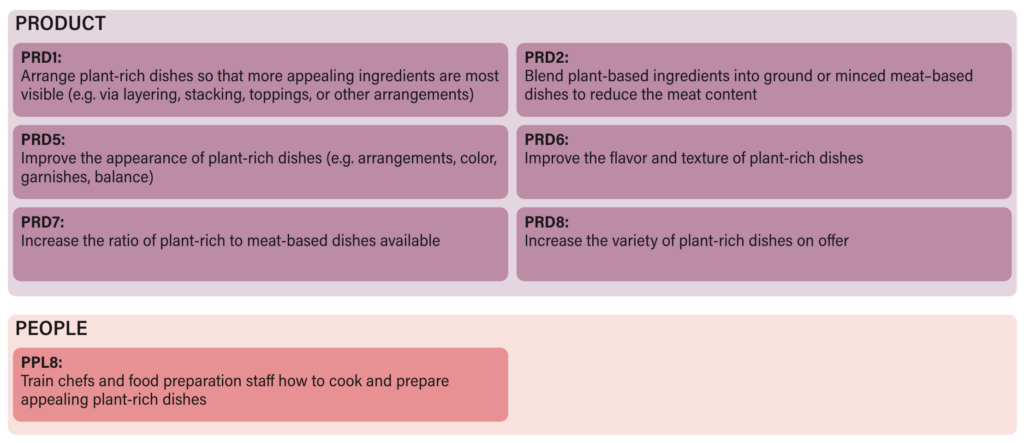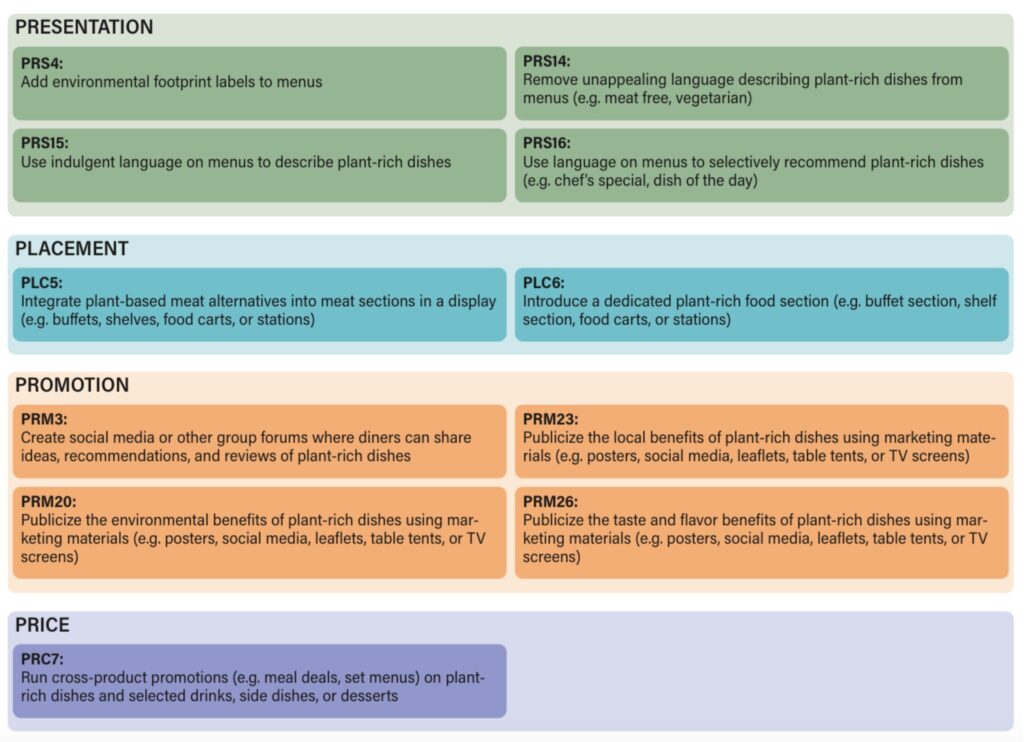The Foodservice Playbook: How to Nudge Diners Into Picking Sustainable, Plant-Based Dishes
6 Mins Read
People’s decisions when eating out are heavily impacted by the dining environments they’re in – here’s how foodservice operators can nudge plant-based choices.
A host of trials recently have shown the power of behavioural science in the food system’s fight against climate change. Some foodservice operators have chosen to make plant-based the default option, for example; others have moved away from words like ‘vegan’ or ‘plant-based’.
All these interventions have varying degrees of success, but studying different behavioural science techniques can help outline robust strategies that encourage low-carbon eating habits in restaurants, colleges, offices and hospitals, among other places.
In 2020, the World Resources Institute (WRI) neatly distilled 57 of these strategies into a playbook to help foodservice operators nudge diners to pick plant-based dishes. As part of its Coolfood initiative to help reduce foodservice emissions by 25% by 2030, the playbook was used by companies collectively serving eight billion meals a year annually. As a result, the members of the Coolfood pledge have cut per-plate GHG emissions by 10% since 2020 already.
But as more research has come out, WRI has compiled those insights to update its foodservice playbook, which now has 90 techniques. Of these, 18 are ‘priority’ techniques that have been found defective and feasible in trials, and operators can adapt without hesitation.
The new priority list is shorter than the 23-strong list in the first iteration of the playbook. But the latest strategies are organised into six categories, as opposed to five. Price now joins the “6P framework”, which retains the previous segments of product, presentation, people, promotion and placement.
WRI decided to add the price category because the one focused on promotions was overly long, and a distinct subset of approaches involving price modification had emerged. Price techniques involve redesigning the cost of plant-rich dishes, plus new ways to incentivise diners to choose these options or otherwise disincentivise selection of meat dishes,” the report states.
Here are the highlights from WRI’s low-carbon foodservice playbook 2.0.
Blended meat, flavour focus and chef support

Some of the highest-ranking techniques in the new playbook fall into the product category, which involves techniques that involve modifying the food being served. Increasing the variety and ratio of plant-rich dishes on offer has been found effective in over two dozen trials collectively, while enhancing the appearance of these options and arranging them so that the most appealing ingredients are visible are highly effective too.
Improving the flavours and texture of dishes is crucial, too. For most people, while health has become an important consideration, taste still drives consumption habits. “Products tasting great is, I would say, a necessary condition for change to happen,” says Sophie Attwood, senior behavioural scientist at WRI, and one of the report’s authors.
WRI suggests that blending plant-based ingredients into conventional meat to reduce the animal content could deliver some key gains. This is an approach that is becoming increasingly popular in the foodservice sector – Disneyland is using 50/50 Foods’ Both Burger, while US meat purveyor Pat LaFrieda has incorporated Mush Foods’ 50Cut mycelium meat into a beef burger.
“One common option is to replace a portion of the beef content with mushrooms, with the ratio of 70% meat to 30% mushrooms already trialled with success in food service,” the report suggests. “Meat will remain the main focal taste of the dish, and diners will likely not notice the difference, all while a significant reduction in GHG emissions can be achieved.”
One of the highest-rated suggestions comes from the people category (which targets foodservice employees), and involves giving chefs access to tools and ingredients that can help them prepare appealing plant-based dishes. This received a 12.44 expert score out of a maximum of 14 – but it wasn’t one of the promising techniques as there have been no trials to support this theory.
However, there have been two studies where chefs have been trained to cook and prepare plant-rich dishes, which has high potential. “It’s in recognition of the importance of chefs to the sustainable food movement by creating healthy and sustainable dishes the diners actually want to buy,” says Attwood. “This is really the cornerstone of the whole movement.”
Carbon labels and the importance of language

How dishes are labelled and communicated to consumers is a key theme of the playbook. This is highlighted by the promotion category, which includes communication, marketing, advertising and campaign approaches. Using marketing materials to promote the benefits of plant-rich diets across flavour, environment and local touchpoints has high potential, as does creating social media groups for diners to share ideas and reviews.
The messaging focus continues with the presentation techniques too (which involve modifying the language, imagery and layout of menus, signs and labels). One of the most trialled and successful interventions is to add carbon labels on foodservice menus.
“Key considerations when adding environmental labels to menus include ensuring that the labels will be understood by diners, communicate relevant information, and do not misrepresent the true impact of different foods across multiple environmental outcomes (e.g., biodiversity, GHG emissions, land use, water use, etc.),” the report suggests. “At present, there is no frontrunner in terms of optimal label design, although certain characteristics, such as the colour green, are received positively by customers.”
Meanwhile, there’s a spotlight on the type of language used on menus, with WRI advocating to remove unappealing terms like ‘meat-free’ or ‘vegetarian’, and instead use indulgent and selective language to describe plant-based dishes (such as ‘chef’s special’ or words describing umami flavours). Multiple studies have shown that people are discouraged from labels like ‘vegan’, and the foodservice playbook confirms their inefficacy.
“The language that we use to describe food can have a powerful influence on how we subsequently experience it. Research shows that certain language works particularly well to evoke mental simulations (or ‘mental images’) of what a dish will be like to eat. If these simulations are positive, they can tempt diners to change their choices by creating desire for plant-rich options,” says the playbook.
Terms like ‘healthy’, ‘light’ or ‘low-calorie’ aren’t too effective either, but flavour descriptors and indulgent wording go a long way. “Enjoyable, figurative language (i.e., use of wordplay, idioms, rhymes, or metaphor) can also have a similar, positive effect.”
The other two Ps of the framework are placement (food displays and physical environment) and price. In the former category, integrating plant-based meat into the same sections as conventional meat is an effective strategy – but so is introducing a dedicated section for plant-rich foods. In terms of price, the most effective way to nudge low-carbon behaviours is to run cross-product promotions involving plant-forward dishes with drinks, sides or desserts.
“Chefs, culinary directors, marketers, and nearly anyone involved in shaping a dining environment has a big hand in also shaping what foods customers choose to buy, everywhere,” says WRI president and CEO Ani Dasgupta. “In the grand scheme, that can make a significant contribution towards accelerating our transition to a healthier and more sustainable food future.”




